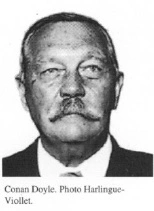Arthur Conan Doyle and his character of Sherlock Holmes
Publié le 01/11/2016
Extrait du document

Arthur Conan Doyle and his character of Sherlock Holmes Theme : Heroes and characters Issue raised : Why would Arthur C.D embody himself as his fictional character Sherlock Holmes ? Sommary Introduction The author’s life The era’s society Why Sherlock Holmes ? Conclusion Introduction In the XIXth century, England goes through the industrial age, bringing an expansion of the city which was so fast that it was difficult to control and organize. The scientific progresses will allow technical innovations which will favorite the press with large prints and illustrations. There will be a temptation of maximization of the number of sold copies daily thanks to serial novels and column, which will often handle cases of unusual murders. It was also at that time that were born the modern police and criminology following the increasing of the criminality. This creates an interest among the people in all that is related to the criminal underworld. It is in these social conditions that emerges scientific detective as Sherlock Holmes, created by Arthur Conan Doyle. In the same way as the industrial revolution symbolizes the success of science towards religion, Holmes embodies the victory of reason over superstition. Indeed, he managed every time to solve the mysteries that surround various murders and has thus never resort to supernatural or mythological explanations. Arthur Conan Doyle, born May 22, 1859, was a XIXth century writer who in 1890 introduced the character of the detective Sherlock Holmes in the novel A Study in Scarlet. During his life, the events in which he will attend will push him to continue writing the adventures of his character. Thus, why would Arthur C.D embody himself as his fictional character Sherlock Holmes? The author’s life Arthur Ignatius Conan Doyle was born on May 22, 1859. He grew up in Edinburgh, in a prosperous Irish-Catholic family. His father, Charles Altamont Doyle was a chronic alcoholic who, apart from fathering a brilliant son, never accomplished anything of note. Mary Doyle, Arthur’s mother, was a master storyteller and she certainly gave her son the desire to write. Her stories, as Arthur described it in his autobiography, also helped him by obscuring the real facts of his life. At the age of 9, his studies were payed by some rich family members, affording him seven years in a jesuit boarding school. He hated the bigotry surrounding his studies and rebelled against brutal corporal punishment, which was common at the time. He found happiness in writing letters to his mother, which lasted until the end of her life, and sports like cricket. During these difficult years, he realized he had a talent for storytelling, and would often tell his invented stories to younger attentive students, who were amused by them. He graduated at seventeen in 1876 and was considered a normal young man, with his sense of humor and love for sport, he was ready to face the world. He had no more self-pity.He later wrote “Perhaps it was good for me that the times were hard, for I was wild, full blooded and a trifle reckless. But the situation called for energy and application so that one was bound to try to meet it. My mother had been so splendid that I could not fail her.”After coming back home from his school, his first task was to co-sign the committal papers of his father, who had become mentally ill. To get a fairly good idea of the dramatic circumstances which surrounded the confinement of his father to a lunatic asylum Arthur Conan Doyle wrote in 1880 a book called The Surgeon of Gaster Fell. Instead of becoming an artist like many of his family members, Arthur decided to follow a medical career. Dr Bryan Charles Waller was the one who influenced his decision, and Arthur then went to the same university as him, the University of Edimburgh. There he met other future authors such as James Barrie and Robert Louis Stevenson. However, the most influencing man for the young medical student was one of his teachers, Dr Joseph Bell, a master at observation, logic, deduction and diagnosis. Later, these qualities were to be found in the persona of one of Arthur’s greatest characters, Sherlock Holmes. A couple of years later in his studies, Arthur wrote his first short story, The Mystery of Sasassa Valley which was marked by Edgar Allan Poe and Bret Harte’s styles. The same year, he wrote The American Tale, published in London Society. Arthur was twenty years old and in his third year of medical studies when he got a chance to live an adventure. The job for the post of ship's surgeon on the Hope was offered to him, in a whaling boat, leaving for the Arctic Circle. At the first stop in Greenland, Arthur was appalled to see the crew brutally hunt for seals, but enjoyed their camaraderie on board and he was fascinated by the whale hunt. He said \"I went on board the whaler a big straggling youth\" and \"I came off a powerful, well-grown man\". He concluded quit some years later that the Arctic had \"awakened the soul of a born wanderer\". He recalled this adventure into his first story about the sea called Captain of the Pole-Star. In 1880 he reluctantly went back to his studies. A year later, he obtained his \"Bachelor of Medicine and Master of Surgery” degree. He even drew a humorous sketch of himself receiving his diploma, with the caption: \"Licensed to Kill”.His first important employment was as a medical officer on the “Mayumba”, an old vessel going from Liverpool to the west coast of Africa, which he did not find as interesting as the Arctic, and soon gave up on that job.He wrote a book about an unscrupulous doctor that he met in Plymouth forty years later in The Stark Munro Letters, and after that he left and went to Portsmouth to open his first practice since he was close to be bankrupt. He rented a house but was only able to furnish the two rooms his patients would see. The rest of the house was almost empty and he had a hard time starting. But his compassion and hard-working payed well, after his third year he was finally able to earn enough to have a satisfying income. The years after were divided by his desire to be a good doctor and struggling to become a recognized writer. In August of 1885, he married a young woman called Louisa Hawkins, the sister of one of his patients. In March 1886, Conan Doyle started writing the novel which catapulted him to fame. At first it was named A Tangled Skein and the two main characters were called Sheridan Hope and Ormond Sacker. Two years later this novel was published in Beeton's Christmas Annual, under the title A Study in Scarlet which introduced us to Sherlock Holmes and Dr. Watson. These two characters became very quickly became world famous. During that time, he also wrote a very strange and confusing tale about the afterlife of three vengeful Buddhist monks called The Mystery of Cloomber. This story illustrates the start of Conan Doyle’s fascination with the paranormal and spiritualism. In August of 1889, he was invited for a dinner at the Longham hotel in London by Joseph Marshall Stoddart, managing editor of Lippincott's Monthly Magazine in Philadelphia. There he met Oscar Wilde, who by then was already quite well known. After this literary soirée, Conan Doyle wrote another short novel: The Sign of Four which was instrumental in establishing Sherlock Holmes and Arthur Conan Doyle once and for all in the annals of literature. In spite of his literary success, a flourishing medical practice and a harmonious family life enhanced by the birth of his daughter Mary, Conan Doyle was restless. He decided the time had come to leave Portsmouth, and go to Vienna, where he wanted to specialize in Ophthalmology. But, after a visit to Paris, Conan Doyle hurried back to London followed by the gentle Louisa. Later, he made the most profitable decision of his life, that of writing a series of short stories featuring the same characters. By then, Conan Doyle was represented by A. P. Watt, whose duty was to relieve him of \"hateful bargaining.\" Hence, it was Watt who made the deal with The Strand magazine to publish the Sherlock Holmes stories. The \"image\" of Holmes was created by the illustrator Sidney Paget who took his brother Walter as a model for the great detective. This collaboration lasted for many decades and was instrumental in making the author, the magazine and the artist, world famous. In May of 1891, while writing some of the early Sherlock Holmes short stories, Conan Doyle was struck by a virulent attack of influenza, leaving him between life and death. As he became better, he realized how foolish he had been trying to combine a medical career with a literary one, so he abandoned his medical one. In 1892, Louisa gave birth to a son they named Kingsley. A year later, the author decided to get rid of Sherlock Holmes because he overshadowed what he considered his better work, even if he was making good profits and everyone telling him not to. This would free him from both medical and the oppressing character. It was during a trip to Switzerland that he decided the Reichenbach Falls would be the place his hero would die. It is in The Final Problem, published in December 1893, Sherlock Holmes and Professor Moriarty plunged to their deaths, resulting to twenty thousand cancelled subscriptions to the Strand Magazine. Conan Doyle immersed himself into even more intensive activity, not noticing his wife’s health deteriorating. And when he did finally notice it, she was giving only a few months to live and was diagnosed with tuberculosis. Her husband took care of her and became a doctor, Louisa being no longer a wife but a patient. He then lost his father, deeply troubling him. Conan Doyle became more and more interested with Spiritualism, probably because of his depression and fascination with “life beyond the veil”. He then joined the Society for Psychical Research. As Sherlock Holmes said to Watson, \"Work is the best antidote to sorrow…\" Conan Doyle accepted to go to the United States to give a series of lectures. He sailed for New York in September of 1894 with his younger brother Innes. He was booked to give talks in more than thirty cities. The tour was a huge success, the author then returned to England in time for Christmas. It was also the time for the publication in The Strand Magazine, of the first of the \"Brigadier Gerard\" stories, which was a success. A trip with Louisa during the winter of 1896 to Egypt, where he hoped the warm climate would do her good, produced another of his novels: The Tragedy of the Korosko. It is believed that Conan Doyle remained celibate durin...

« Theme : Heroes and characters Issue raised : Why would Arthur C.D embody himself as his fictional character Sherlock Holmes ?. »
↓↓↓ APERÇU DU DOCUMENT ↓↓↓
Liens utiles
- Le personnage d'HOLMES Sherlock. Arthur Conan Doyle
- « Sherlock Holmes – La vallée de la peur » de Sir Arthur Conan Doyle
- Le chien des Baskerville de Sir Arthur Conan Doyle
- Essay English : In Arthur Miller’s play “All my sons”, Joe Keller is a hero in his family and in the neighborhood even if he did some very awful things.
- Arthur Conan Doyle - idiomas.

































